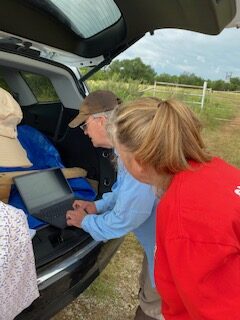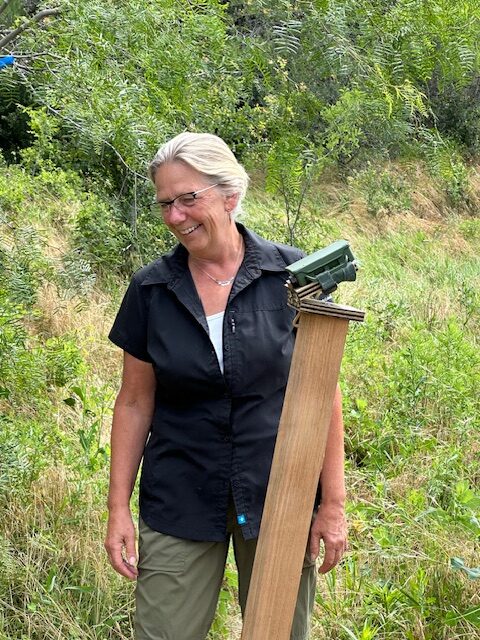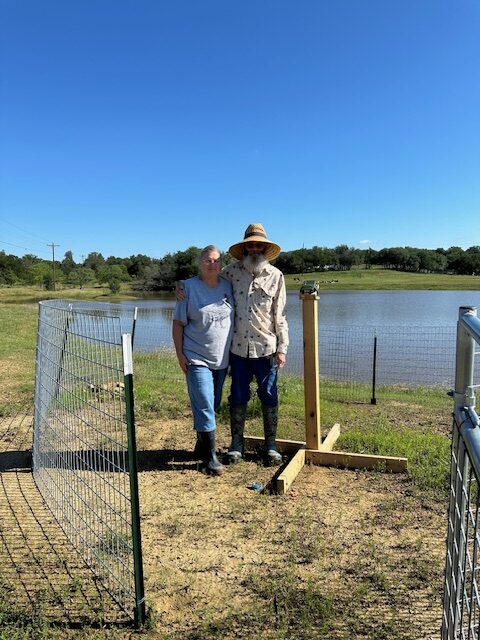By: Marsha Stephens —
In the summer of 2023, while watching a wildlife diversity webinar on horned lizards, I heard a brief mention of a possible new project within the Texas Nature Trackers program. I couldn’t believe my ears; the project was envisioned to be a statewide survey of BATS! If you went through initial certification training with the Prairie Oaks chapter, you may remember that I have a lifelong fascination with bats, born of early coursework and field studies in Mexico with a leading bat biologist. Later in my career, I spent many nights with my mist nets beside tanks and streams to capture and document desert bat populations. Now suddenly here was an opportunity to return to my roots in bat biology, AND learn a whole new technology that has revolutionized wildlife research. This new project employs acoustic monitoring, with equipment to record echolocation calls emitted by bats. Using advanced software, the resulting data can be analyzed to identify the species of bats producing the calls.

The BAT Acoustic Monitoring Project was introduced to the Texas Master Naturalist (TMN) program in January 2024. The project has been funded and approved for an initial three-year period, with the potential of extension to multiple additional years. The project is being conducted statewide in Texas, a massive volunteer undertaking with at least 43 TMN chapters participating and over 400 volunteers involved. A simplified statement of the project mission is to provide new data on bat species occurrences, using acoustic monitoring and expert systems analytical software. Texas boasts records of the greatest number of bat species (now 34) of any U.S. state, and we love our bats! State resource managers need to know more about their current distributions, particularly in light of many potential threats to bat populations, like the fungal disease white-nose syndrome.
Members of the Prairie Oaks BAT Project team have made great progress since the program began in January and we are nearing completion of field sampling for 2024. Following an introductory training session in January by the state-level project manager, Craig Hensley (Texas Nature Trackers Biologist with Texas Parks & Wildlife Department), chapter members interested in volunteering for the project registered into official participation. Possible roles for participation include various coordination activities, equipment deployment, equipment hosting (for property owners) and data management and analysis. A total of 20 Prairie Oaks chapter members have registered to participate in the project. During February through May, additional online meetings and training were provided by the state leaders. Many of our volunteer team have also completed online training classes for data processing and analysis provided by Wildlife Acoustics, one of the makers of equipment used for acoustic monitoring.

In early April, our chapter received the two acoustic monitoring units assigned to us for the project, an AudioMoth and a Song Meter Mini Bat (we fondly refer to them as The Moth and The Bat). After some intensive hands-on training and individual practice, three of the team (Linda Wood, Lynn Wood and I) became the deployment squad for programming, transporting, setting up and retrieving the units for each Monday-Friday sampling period during the 9-week sampling season. Prior to actual placement of equipment, the property-owner volunteers (see below) provided location information that allowed for identifying a location code from the USGS North American Bat Monitoring (NABat) program. This code, called a GRTS number will be used when our project data is eventually submitted to the NABat database. Measurements were then made using the GRTS system to ensure that our sampling locations are at least 5 km apart, a standard established by NABat.
Before any equipment was placed in the field, we visited each property owner and identified the best possible location to maximize the potential for recording any bats present. Amidst learning how to use the equipment and interpret the results, Lynn Wood also constructed two wooden stands that are being used to hold the acoustic monitoring units when they are transported to a new location each week. This has been invaluable in allowing us to place the units in the best possible position at each sampling site, rather than having to resort to using an existing fencepost or other fixture.

The acoustic monitors were first deployed the week of April 29, with each unit placed at a site on Monday morning and retrieved on Friday morning. During the days when the unit is present, the property owner is responsible for routinely checking to make sure the equipment is undisturbed, and for recording data on temperatures, rainfall and unusual events that may occur during the sampling period. The landowner also receives a loaner copy of the book “Bats of Texas” (Ammerman et. al, 2012) to allow for reading to learn about the species that have been previously documented as occurring in our chapter region.
The acoustic monitoring units are programmed to begin recording a minimum of 30 minutes before sunset and stop recording 30-60 minutes after sunrise. The recording format is a little different between the two types of detectors, but both produce good quality data. When we retrieve the equipment on Friday, we do a quick check of the generated data files, and if possible, we show the property owner a recording of a bat call from that sampling site. Although we don’t at this point have complete access to the software needed for species identification, we can sometimes make a pretty good guess as to the species producing the call in the recording. And here is the headline: WE HAVE BATS EVERYWHERE! At least one landowner had clear evidence of three different species present, and even without a complete review of the data generated thus far, bats have been recorded at every location sampled. I think I am safe in vouching that our landowner volunteers are pleased with the results already.
Once field sampling is completed at the end of June, the archived data files will be uploaded to the state project office. There the data will be processed through the expert systems software (Kaleidoscope Pro). Each chapter will then receive the analytical results from the sites sampled by that chapter, which will include preliminary identifications of species. Using that information, we will provide the participating property owners with a brief summary of the preliminary results and any relevant information. At that point, members of the team who have been training to serve as data analysts will begin work on reviewing the results produced by the software processing, to determine species identifications that meet the criteria for acceptance as valid. The review process will likely require several months to complete, although there will be an effort to round up the best data available for presentation at a workshop at the TMN State Meeting in October. We hope to be able to present final results as part of an overview of the project for a chapter meeting before the end of the year. Spoiler: among other surprises, we have gotten some strange sounds on our recorders.
Many thanks to the member property owners who are serving as hosts for the sampling equipment: Linda & Lynn Wood, Joe Wallace, Lance Trinque, Steve Trine, Peggy Tolboom, Velda Tiblets, Barbara Salter, Karen & Bruce Phifer, Moira & Brian McCue, James Gray, and Gail & Bruce Bradshaw. As I have noted during chapter meetings, there are many participating TMN chapters in the state that are many times larger than ours, that do not have as many volunteer host property owners as we do. We are very fortunate to have this level of participation.
Stay tuned, we are flying high!



